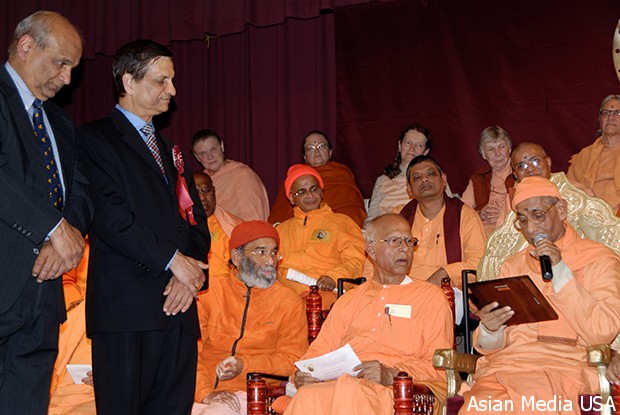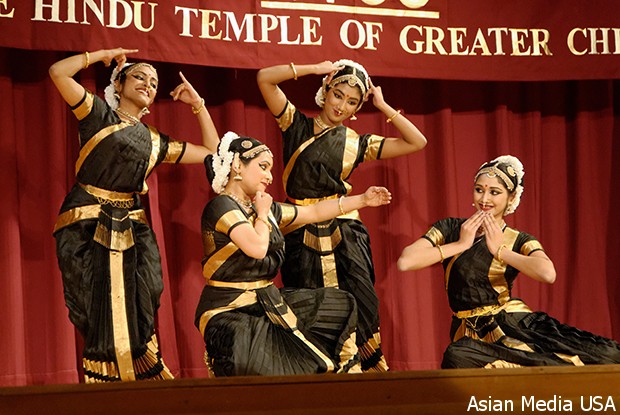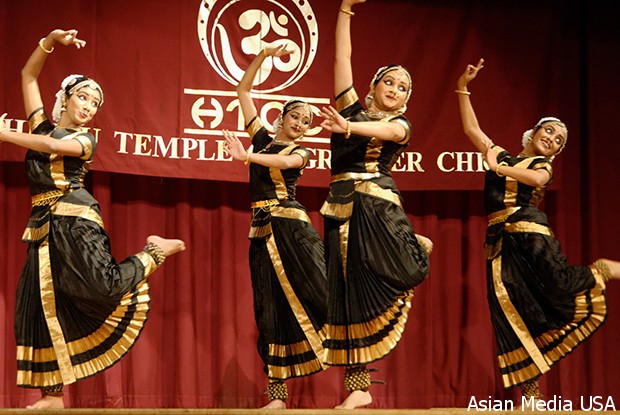Hindu Temple Honors Visiting Monastics for Swami Vivekananda’s 150th Birth Anniversary
Chicago IL: Almost fifty monastics including a dozen nuns of the Vivekananda Vedanta Society (VVS) and Ramakrishna Mission, coming from all over the world, were honored by the Hindu Temple of Greater Chicago (HTGC) the evening of Friday, November 8, 2013 on behalf of the diaspora of householders. Bused in after a day of deliberations at the Vivekananda Monastery at Ganges, Mich., they disembarked before the giant statue of their Founder-Swami that they venerated and circumambulated before granting a brief audience to the awaiting devotees at the adjacent meditation center named after him. The packed Sama Rathi auditorium within the main temple complex was then treated to the unprecedented sight, as the curtain was raised, of the seated monastics arrayed across three tiers of the grand stage as cameras kept flashing furiously. Six representative speeches, by way of greetings, were followed by a cultural program and dinner.
The main program at the auditorium began with an invocation of Ganesh and Tulsidas bhajan on Lord Rama. Prayers offered by the temple priests were followed by welcome speeches from HTGC past President Bhima Reddy and current President Tilak Marwaha. Sanskrit prayers to Shri Ramakrishna, Swami Vivekananda, and Ganesha followed the lighting of the auspicious lamp.
Minister-in-Charge of VVS Chicago Swami Ishatmananda applauded the “nice scene on stage” comprising “nice people, who have renounced all to serve the world.” He enumerated their often far-away places of origin. Swami Tyagananda from Boston, who is chaplain at Harvard and MIT, emphasized the need for external festivities to be also celebrated internally if they were to be long-lived. We should take up at least one teaching of Vivekananda and put it to actual use, a prescription that he illustrated the next day on the example of the quality of strength.
American convert Swami Atmajnananda from Washington DC recounted how, as a student of Western and Indian philosophy, he found what he was looking for when he picked up the Gita and then a small book for five rupees on The Teachings of Vivekananda. Staying with a family in Kolkata, he had walked barefoot in the scorching heat to Belur Math and was overwhelmed by the Dakshineshwar Kali temple and Shree Ramakrishna’s room. Born of a Lutheran mother and Baptist father, who were already adrift from their religious moorings, Pravrajika Vajraprana explained how they came to Vedanta around the same time: “This country is built around the idea of freedom so central to Swami Vivekananda’s teaching.”
Indian Swami Nirmalatmananda from Sao Paulo spoke of Argentina and especially Brazil. “People are looking for something more despite 500 years of Christianity and language barriers.” Vivekananda left a mold to develop one’s spiritual potential and translate it into service to humanity. He urged people to be strong; be rational and scientific and yet have sympathy for all forms of worship; learn to be calm and quiet inwardly even while engaged in intense external activity; and make spirituality a cheerful pursuit.
Indian Swami Baneshananda from Germany emphasized the principle of harmony through mutual acceptance, illustrated by the ancient Hindu custom of family altars exhibiting multiple deities and each member practicing the religion in his or her own way. He criticized a Hindu leader’s recent speech advocating the uniformization of beliefs and practices. General Secretary of Ramakrishna Mission Swami Suhitanandaji was touched by the selflessness of all present: “the great man is he who sacrifices the most, and India’s death will be the death of world spirituality.” He cited Sister Nivedita’s statement that Hinduism was born with its defense by Vivekananda defense at the World Parliament of Religions. He praised HTGC for including (the statue of) Vivekananda within its traditional pantheon.
Devotees who had accompanied the monastics from faraway lands were invited to file before them across the stage and were appreciatively captured on photo to mark this historic occasion. They were followed by dedicated temple volunteers who had made this even possible.
Lakshmana Agadi made an unscheduled appearance to felicitate Bhima Reddy, the “Hanuman of the Temple,” who was conferred plaque on behalf of the monastics and gave an emotional expression of gratitude for this unexpected honor. Amrish Mahahajan, Chair the HTGC celebration committee, and other members posed for photos with monastics. The Mayor of Oakbrook Gopal Lalmalani and his wife also paid obeisance to the monastics.
Chair of the HTGC Cultural Committee Usha Pariti then emceed classical dances presented by Natya Dance Theater (NDT) and Ananda Dance Theater (ADT). Asha Rowland (NDT) performed “Praise of the Goddess” (Devi Stuti) depicting her manifold expressions from the Lalita Sahasranamam. Janaki Anandavalli Nair (ADT director), Elizabeth Nellamattathil, Leah Kunneth, and Divya Pariti, presented Baro Krishnayya in Kuchipudi style. Revati and Rohini Kalluri presented “Manifestations of Shiva” (NDT) in Bharata Natyam, followed by Dandayudhapaani Pillai’s Thillana in ragam Hindolam by the same ADT team. Sacred Waters musical ensemble from South Bend, Indiana, sang interactive American-style bhajans to conclude the program.
The monastics, not averse to the aesthetics of religion, remained for the earlier half of this entertainment program. Several clicked their cameras enthusiastically and others could be overheard commenting on the beauty of the dance, before they were shepherded away to the dining room early in view the long conference weekend ahead from early next morning.
Housed in its open dome, the imposing statue of the Swami in his self-confident pose that greets all visitors to the Lemont temple is a gift of the Ramakrishna Mission. Originally intended to adorn that short stretch of Michigan Avenue before the Art Institute called “Swami Vivekananda Way,” it seals the bond between the Hindu diaspora community and his still ongoing mission.
Photo captions for HTGC “Honoring the Monastics” on Nov. 8 (in order of priority):
#175 = Visiting monastics onstage at HTGC Sama Rathi auditorium; seated on the floor before them are members of the HTGC temple committee.
#035 = Monastics rendering obeisance to the Swami Vivekananda statue as HTGC President Tilak Marwaha (extreme right) looks on.
#066 = Monastics grant audience to devotees at HTGC Vivekananda Meditation Center. Swami Ishatmananda (standing with mike) expresses his appreciation.
#157 = HTGC Past President (L) receives felicitation plaque for his services to the temple from General Secretary of Ramakrishna Mission Swami Suhitanandaji (holding mike).
#184 = Some of the devotees from abroad seated before the assembled monks.
#212 = Asha Rowland from Natya Dance Theater performs “Praise of the Goddess” (Devi Stuti) from the Lalita Sahasranamam.
#233 = Danseuses from the Ananda Dance Theater coddle the infant Krishna during their performance Baro Krishnayya in Kuchipudi style.
#238 = Revati and Rohini Kalluri from Natya Dance Theater perform “Manifestations of Shiva,” here depicted mounted on his bull Nandi.
#266 = Janaki Anandavalli Nair, Elizabeth Nellamattathil, Leah Kunneth, and Divya Pariti of Ananda Dance Theater perform Dandayudhapaani Pillai’s Thillana in ragam Hindolam



